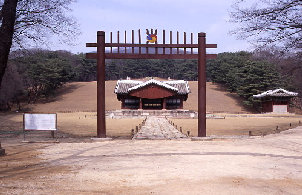Heoninneung Royal Tomb Surrounded By Stone Statues
Mt. Daemosan behind Heoninneung Royal Tomb in Seoul was originally called "Halmisan" (meaning grandmother in Korean) since it resembles the shape of an old lady.
Mt. Daemosan embraces Heoninneung Royal Tomb in Seoul, guarding the royal tomb. Features of Heoninneung Royal Tomb
- It houses the mounds for two kings of the Joseon Dynasty (1392-1910): King Taejong (1401-1418) and King Sunjo (1800-1834).
- It possesses numerous stone statues and vestiges and is a good place to experience the culture of the Joseon Dynasty.

- Upon entering the grounds, the striking red gate with the Taegeuk (yin-yang) symbol appears to draw the line between this world and the one beyond.
- Passing the red gate leads to a sacrificial building where ancestral memorial services were performed.
- Behind the sacrificial building is the royal tomb. The royal tomb is surrounded by statues carved in the shape of animals such as tigers and sheep.
- On the eaves of the sacrificial building are animal sculptures called Japsang that are believed to exorcise evil spirits.
- There is a pavilion next to the sacificial building where the tombstone is situated.
- There is also a statue of a solemn military officer bearing a sword with his horse behind him.
- The stone sculptures are guardians of the dead king.
Heoninneung Royal Tomb Back to Historic Sites





